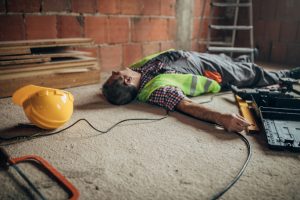
The truth is that electrocution accidents are more common than most people realize. Whether a person dies, suffers significant burns, or deals with another injury entirely, these are always serious accidents. Keep reading to learn about the most common causes of electrocution accidents and how you can reduce your chance of becoming a victim.
If you have already been injured in this type of accident, or if you have lost a loved one in an electrocution accident, contact Law Offices of Fernando D. Vargas at 909-982-0707 for a free legal consultation.
The Most Common Causes of Electrical Accidents
According to the National Institute for Occupational Safety and Health (OSHA), the top causes of electrical accidents are:
- Not maintaining safe clearance distances
- Drilling/cutting through cables
- Using old, defective tools, equipment, and cables
- Failing to de-energize circuits and follow safe tagout/lockout procedures
- Improperly installing or using temporary electrical systems and equipment
- Not guarding live parts against accidental contact
- Allowing unqualified persons to work with electricity
- Bypassing protective devices
As you can see, most of these causes are not accidents at all, they come from employers or employees not following correct procedures or not having access to safe equipment.
Follow These Rules to Stay Safer Around Electricity
The Army’s Electrical Safety Regulation is considered the gold standard for staying safe from electrical hazards. It suggests that accidents can be prevented if:
- Personnel know where the hazards are
- There are no energized surfaces or exposed parts
- All equipment is properly maintained
- Barriers and devices are used when necessary
- Plugs or receptacles that can change polarity are never used
- Conductors are not placed in such a way that they can be walked on or tripped over
- Metal objects, such as jewelry, are not allowed around electricity
- All connecting plug-ins are properly attached
- Protective devices are installed and used
- Circuits and conductors are not overloaded
- No one goes near an unguarded conductor
- Cords are inspected before each use
- Cords are never pulled or tugged on
- Plugs and receptacles have the correct mating configuration
- Damaged cords are not used
- Nails, staples, and screws are never used to attach cords or plugs
- No more than one conductor cord is used
- Cords are kept clean and free of damage
- There is enough slack given to keep strain from occurring on plugs or receptacles
- Plug-receptacles have at least eight ounces of contact tension
- Only equipment that is approved to be used in wet or damp areas is used in these areas
- Cords are of continuous length and do not include splices
- Cords that cross passageways are protected, signs are posted, and are used only for a short time or in an emergency
As you can see, there are many rules that should be followed. If you or a loved one has suffered an injury due to someone or some company not following these rules, then you might have a personal injury claim. Contact Law Offices of Fernando D. Vargas at 909-982-0707 to request a free legal consultation.




